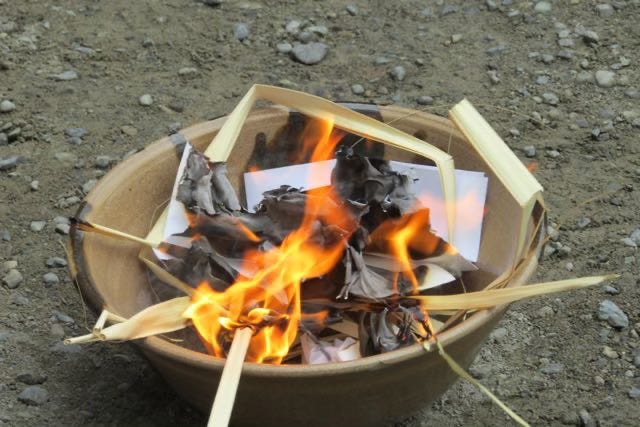Next Wednesday is Ash Wednesday, the beginning of Lent for Western churches, and though most of us have heard of Ash Wednesday and are getting ready to celebrate it with the imposition of ashes on our foreheads, many of us are a little confused about the days that precede it. However I thought that this was a good time to think about adding Clean Monday and Shrove Tuesday to our liturgical calendar even though these are not celebrations most Western Christians are aware of. However I encourage you to think about one practice for each of these days that you might like to use net week as you prepare for Lent.
Clean Monday
For Eastern Orthodox Christians, Clean Monday, the Monday before Ash Wednesday, is the first day of Great Lent. In Greece it is a public holiday. Because Orthodox celebrations still follow the Julian calendar rather than the Georgian calendar the beginning of Great Lent does not always coincide with Western Lent. Clean Monday is a reminder that we should begin Lent with good intentions and a desire to clean our spiritual house. It refers to the leaving behind of sinful attitudes and non-fasting foods, a day of strict fasting for Eastern Catholics and orthodox, including abstinence not only from meat but from eggs and dairy products as well.
This is the traditional day for spring cleaning and next Monday I plan to clean out my office space and set up my sacred space ready for Lent.
As I reflected on this I realized that this desire to clean things up is far more significant and more intentional than we realize.
If we want to do a thorough job of cleaning first we must notice that something is dirty, not the way it is meant to be. Second we must make time to do something about it. Third we must take action. Cleaning is a very intentional activity. Dirt does not disappear without a concerted effort to get rid of it. Sometimes it requires a lot of work. We need to recruit help and purchase supplies.
In some ways cleaning is a thankless job because a space never remains clean. We need to do the job over and over again. However, hopefully in the back of our minds is our vision of what the space could look like if it was clean and its inspiration keeps us cleaning.
Think of an area in your home that you would like to clean up. Visualize in your mind how you would like it to look. What would you need to do to accomplish that? When my desk is messy it is harder for me to focus and I am more easily distracted. What are the parallels you see in your life to the physical cleansing you need to embark on?
As I read through the Isaiah passage I was struck by the three dimensions of spiritual cleanliness – personal cleanliness, cleanliness in our attitudes towards the most vulnerable in our world, and cleanliness in our treatment of the earth. Cleanliness is not just some inner resolve it involves outward actions that lead to personal and societal transformation.
As you read through these verses what came to your mind? In what ways could you “clean up your act”:
1. personally – what dirt do you notice in your personal life that needs to be cleaned up? What actions do you need to take over the next few weeks to accomplish that?
2. towards the most vulnerable – are there dirty corners in your attitudes towards those at the margins? Do you take advantage of cheap labour, show contempt for the homeless or conflict with those of other ethnic backgrounds? How do you treat those of other sexual orientations? How could you work for justice and compassion for the world’s vulnerable?
3. towards the earth – healthy food and a healthy earth require good organic production methods, responsible consumption and conservation of the earth’s resources. What changes could you make in your lifestyle that result in more healthy food and a healthy earth? How could you work to be a better steward of God’s good creation?
Shrove Tuesday
Shrove Tuesday is the day before Ash Wednesday, the beginning of Lent in the Western Church. “Shrove” is the past tense of the word “shrive,” which means to hear a confession, assign penance, and absolve from sin. Shrove Tuesday is a reminder that we are entering a season of penance.
Shrove Tuesday is also known as Fat Tuesday or Mardi Gras (which is simply French for Fat Tuesday). In Italy, Fat Tuesday is known as carnevale – goodbye to meat – from which we get our English word carnival. Traditionally people held one last rich feast, using up perishables like eggs, butter and milk before the fast of Lent began. Now in some places, like New Orleans, this has become a huge celebration that really has nothing to do with the beginning of Lent. Our church, St Andrews Episcopal in Seattle always holds a wonderful Mardi Gras celebration that is also a fundraiser for the youth team’s summer outreach. It is a wonderful opportunity to celebrate together and enjoy New Orleans Jambalaya.
For many however this is still a significant liturgical celebration. Churches often hold pancake suppers, sometimes as a way to reach out to their neigbours. You can find a great collection of recipes and traditions from around the world for Shrove Tuesday in Fat Tuesday Recipes. If your church does not celebrate Shrove Tuesday you might like to consider this wonderfully creative Shrove Tuesday celebration by Lilly Lewin.
The following prayer of St. Ephrem the Syrian is a common prayer used during this season.
O Lord and Master of my life, keep from me the spirit of indifference and discouragement, lust of power and idle chatter. [kneel/prostration]
Instead, grant to me, Your servant, the spirit of wholeness of being, humble-mindedness, patience, and love. [kneel/prostration]
O Lord and King, grant me the grace to be aware of my sins and not to judge my brother; for You are blessed now and ever and forever. Amen. [kneel/prostration]
Ash Wednesday
For many of us, Ash Wednesday (March 5th this year) marks the beginning of a personal journey as we join Jesus in his final days. Unfortunately, many of us treat the season of Lent like a game – more like the cricket match called The Ashes than like the serious turn around time it is meant to be. We come to the season with a list of trivial things we intend to give up – TV, video games, chocolate, but most of us don’t really take the season seriously or use it as a time to dig deeply into our hearts to sweep out the corners in which sin has accumulated. The ashes used in church services on Ash Wednesday are traditionally made by burning the Palm Sunday crosses from the previous year so a couple of years ago I decided to experiment.
I like to burn crosses I took home the previous year to use as part of my Lenten ritual. I deliberately keep my Palm Sunday crosses as a reminder throughout the year of Jesus sacrifice then I burn them at the beginning of Lent to remind myself that the repentance I seek at this season is only possible because of the incomprehensible gift of Christ and his death on a cross 2,000 years ago. During COVID, when we were unable to attend traditional Ash Wednesday services, I burned a couple of old masks instead as you can see in the video below. On other occasions I have written on pieces of paper what I hope to see transformed during Lent. I then like to use the ashes to make a simple piece of art that will sit on my desk as part of my Lenten sacred space.
Burning my Palm Sunday cross each year has a big impact on me. It reminds me that the crucifixion is not really meant to be the focus of our mourning and fasting. We mourn and fast not because we are heading to the cross but because we want to shed all that disrupts our intimate walk with God. We look beyond the cross to the life of God’s kingdom. Asking myself what still needs to be repented of and transformed in my life so that I can be an effective citizen of God’s resurrection created world is probably the most important question of Lent. I want to become all that God intends me to be. I want to leave behind all that prevents me from becoming that person. I want to thirst for righteousness and hunger for justice rather than for water and food.







